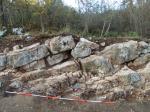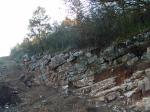Summary (English)
Due to the construction of the main gas pipeline Pula – Karlovac, it was necessary to perform an archaeological survey of the terrain for the conservation study of the impact on the archaeological heritage. It was determined that the route passes along the very edge of the protected archaeological site Gradišće – Orišje near Bosiljevo. During the reconnaissance and the making of the study, many fragments of prehistoric pottery were found and a rescue archaeological excavation was agreed upon. Namely, at the top of the hill was a prehistoric settlement, i.e. a hillfort from the Late Bronze and Iron Ages, whose southern peripheral part should be the future route of the gas pipeline.
The trench is 160 meters long and 2 meters wide, which is the overall width of the pipeline itself. The total length of the excavation was divided into sections (probes A-H) of 20 meters each. Gradišće – Orišje was excavated in the larger part of the planned trench, while the remaining part was explored with five test probes that had no archaeological findings, and the bedrock was located at a shallow depth. Due to archaeological finds, the excavation was extended in several places outside the axis of the route (probes AA, GG, HH). In the western part of the trench, a large amount of archaeological artefacts were found in probes A and AA inside a deep ravine, which was probably used as a waste pit of prehistoric inhabitants of the hillfort. Larger fragments of daub and burned house floors were found in the pit, which could not have gotten there solely by runoff from the hillfort. The pit is the only place on the route where archaeological finds were deposited during the existing life in the settlement. In the eastern part of the trench, a backfill from the hillfort was inspected, which covered a steep rock. Archaeological artefacts found in the backfill got there after the destruction of the hillfort, dating to the Late Bronze and Iron Ages. In that same layer, contemporary finds (ammunition shells from World War II, etc.) were found, which proves that the layer was formed after the life of a prehistoric settlement.
The settlement on Gradišće – Orišje is located at the crossroads of the southern Iapodian and northern Colapian tribes. According to the finds, it was clearly occupied by an indigenous Iron Age population that was “latinized” at the end of the Iron Age. This can be seen primarily on the pottery, which shows an older Illyrian tradition, but with a visible Celtic-La Tène influence. According to the information recovered, the route of the gas pipeline passes outside the “ramparts”, so the prehistoric settlement itself is not endangered by the construction works. However, due to the great technical complexity of the construction of the pipeline, there is a possibility of changes in the predetermined route, so there is a need for constant archaeological supervision during any construction works (L. Bekić 2006, Hrvatski arheološki godišnjak 2/2005, 182–183).
- Luka Bekić
Director
- Luka Bekić
Team
- Ivana Haraša
- Robert Čimin
Research Body
- Hrvatski restauratorski zavod
Funding Body
- Plinacro d.o.o.






![Download [PDF]](/excavation/skins/fasti/images/results/download_sml.png)
